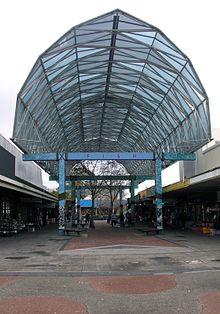Otara
| Ōtara | |
|---|---|

A part of the Ōtara town centre.
|
|

Location of Ōtara in Auckland.
|
|
| Basic information | |
| Local authority | Auckland Council |
| Local board | Ōtara-Papatoetoe |
| Surrounds | |
| North | East Tamaki |
| Northeast | East Tamaki |
| East | Flat Bush |
| Southeast | Clover Park |
| South | Clover Park |
| Southwest | Papatoetoe |
| Northwest | Middlemore |
Ōtara is a suburb of South Auckland, New Zealand (formerly Manukau City), situated 18 kilometres to the southeast of the Auckland CBD. Ōtara lies near the head of the Tamaki River (actually an arm of the Hauraki Gulf), which extends south towards the Manukau Harbour. Contemporary Ōtara is surrounded by the suburbs of Middlemore, Papatoetoe, Clover Park and Flat Bush. The suburb is noted for its proportion of Pacific Islander residents, who make up 68% of the Ōtara population and its unusually low number of European New Zealanders (Pākehā) residents (13%).
In the Māori language, Ō-Tara means ‘the place of Tara’ or ‘territory belonging to Tara’, who was a Rangatira (or Māori Chief) of the area. 'Ōtara' is in turn the shortened form of Te Puke o Tara (literally; ‘The Hill of Tara’); known also for a time as Smales Mount. Te Puke o Tara was one of Ōtara's prominent volcanic cones, and prior to European settlement in the area was the site of a scoria cone Pā. Like most of Auckland, the Ōtara landscape is volcanic in origin and forms a part of what is known as the East Tāmaki volcanic field, with Te Puke o Tara and Mātanginui (Greenmount) having been the dominant cones of Ōtara. A third cone called Highbrook by pakeha (white/European) settlers and in Maori Te Puke Ariki nui or Te Maunga/mountain of the Great/paramount chief. Mātangi nui was also a Pā site, and the areas surrounding all three cones were thought to represent the densest area of pre-European settlement in East Tāmaki, favoured rich volcanic gardening soils and fresh water springs.
...
Wikipedia
